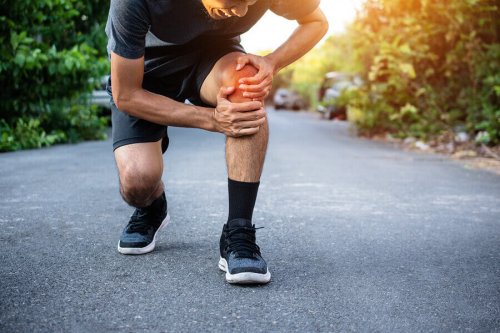Pain when Playing Sports: is it Normal?

Everyone’s who’s ever played a sport knows that injuries are a common risk. What’s more, you probably know firsthand about the soreness, fatigue, and the barriers your physical condition can impose on you. But is pain when playing sports normal?
Playing a sport
Let’s talk about what it means to play a sport – it doesn’t matter which one. All you’re really doing is contracting and relaxing a series of muscles. You’re doing all this through your brain and your nerves.
The muscles, in turn, move the bones to which they’re attached. They’re attached to these by the tendons. That’s how you shoot or throw a ball. The same goes for walking, swimming, and even picking up your water bottle to have a drink.
At the same time, when you move your muscles and bones, you activate other structures. These make your movement fluid and normal. These structures include the tendons, which we previously mentioned. The ligaments and the joint capsule are also included within this group. Meanwhile, the heart is pumping blood more rapidly. That ensures that all of the parts involved in this process have a sufficient supply of oxygen.
As you probably know, exercising has numerous benefits. Here are just a few of them:
- Strengthens the muscles
- Maintains tendons “on alert” so they activate themselves more quickly and effectively
- Maintains and improves neural connections
- Helps to prevent cardiovascular issues
- Strengthens your bones through the absorption of old cells and the creation of new ones
- Gives you a feeling of well-being due to the release of hormones
All of these reasons explain the importance of playing sports for a healthy lifestyle. If you avoid exercise, you may experience opposite effects to those described above.
Nevertheless, for various reasons, sports can also cause pain or discomfort. Let’s see under what circumstances this occurs and when we should seek the help of a professional.

Sports and pain
This tree has several branches, so let’s trim the ones that are getting in the way. That way we’ll be able to tackle the issue more easily. First of all, let’s exclude fatigue from this conversation. You’re working your muscles, after all. That means that whether you’ve been a couch potato or just cranked up the weight during training sessions, your muscles are going to become tired.
This means that it’s normal for the exercise to feel harder the longer the session goes on. When you get home and plop yourself onto the bed, you might even have trouble getting up. The muscles have been working and need recovery time. That much, at least, is very normal.
Next, there’s the matter of soreness. You might notice some discomfort in the muscle group that you were using. This could last up to two or three days after putting in more effort than usual. That’s also a normal occurrence and it shouldn’t worry you.
What’s happening here is that you’ve torn muscle fibers. That’s why it hurts. But not to worry. They’ll grow back, and even stronger than ever. That’s because your body is wise and it wants you to be able to handle the next exercise session of a similar intensity that comes your well. Sleeping well and doing light exercise with the muscle group that feels soreness accelerates recovery.
When pain isn’t normal
Stronger pain than that probably isn’t normal and can be a big problem. This is what you can really call an “injury.” If you move in a strange and sudden way and that part of your body begins to hurt, you might have damaged something. This could be an injury to your muscles, tendons, ligaments, nerves, bones, cartilage, or joint capsules. When this is the case, it’s best to have a specialist examine the area in question.
Then you have the case where something starts to hurt from the beginning of your training session. As we said before, muscular fatigue is normal. There’s no reason for alarm if you notice a little bit of discomfort or light pain when you’ve been on the field for a while. What’s not normal is to feel pain from the beginning. If this happens to you, you should have some tests to find the source of your pain.
On the other hand, it’s also possible that you’re executing a movement incorrectly. Take this humdrum situation, for example. Suppose you’re squatting in such a way that your knees are jutting way past your toes. This movement is wrong and it could cause you knee pain.
This is how the body warns you that you’re doing something wrong. This type of pain isn’t normal. You have to ease yourself into things in these types of cases. If you’re just getting started with a sport or a new exercise, you have to make sure you’re executing its movements correctly.

Sports and pain: conclusions
In conclusion, you could say that pain warns you that something’s gone wrong. There’s a trend among some men to play sports when they feel pain to feel more masculine. What’s more, plenty of elite athletes look for quick ways to get over discomfort so they don’t interrupt their careers.
Both of these paths can harm their bodies. Furthermore, the chances go up that their condition will worsen or they’ll experience new injuries. Pain when playing sports in these cases isn’t normal, but they’re willing to suffer it for reasons of their own.
People who aren’t professionals should never continue if they feel pain when playing sports. Feeling tired or a little discomfort due to muscle soreness is ok. On the other hand, any type of sharp pain that bogs you down when you play a sport can be a big problem. It can be a symptom of an underlying issue you need to deal with.
Everyone’s who’s ever played a sport knows that injuries are a common risk. What’s more, you probably know firsthand about the soreness, fatigue, and the barriers your physical condition can impose on you. But is pain when playing sports normal?
Playing a sport
Let’s talk about what it means to play a sport – it doesn’t matter which one. All you’re really doing is contracting and relaxing a series of muscles. You’re doing all this through your brain and your nerves.
The muscles, in turn, move the bones to which they’re attached. They’re attached to these by the tendons. That’s how you shoot or throw a ball. The same goes for walking, swimming, and even picking up your water bottle to have a drink.
At the same time, when you move your muscles and bones, you activate other structures. These make your movement fluid and normal. These structures include the tendons, which we previously mentioned. The ligaments and the joint capsule are also included within this group. Meanwhile, the heart is pumping blood more rapidly. That ensures that all of the parts involved in this process have a sufficient supply of oxygen.
As you probably know, exercising has numerous benefits. Here are just a few of them:
- Strengthens the muscles
- Maintains tendons “on alert” so they activate themselves more quickly and effectively
- Maintains and improves neural connections
- Helps to prevent cardiovascular issues
- Strengthens your bones through the absorption of old cells and the creation of new ones
- Gives you a feeling of well-being due to the release of hormones
All of these reasons explain the importance of playing sports for a healthy lifestyle. If you avoid exercise, you may experience opposite effects to those described above.
Nevertheless, for various reasons, sports can also cause pain or discomfort. Let’s see under what circumstances this occurs and when we should seek the help of a professional.

Sports and pain
This tree has several branches, so let’s trim the ones that are getting in the way. That way we’ll be able to tackle the issue more easily. First of all, let’s exclude fatigue from this conversation. You’re working your muscles, after all. That means that whether you’ve been a couch potato or just cranked up the weight during training sessions, your muscles are going to become tired.
This means that it’s normal for the exercise to feel harder the longer the session goes on. When you get home and plop yourself onto the bed, you might even have trouble getting up. The muscles have been working and need recovery time. That much, at least, is very normal.
Next, there’s the matter of soreness. You might notice some discomfort in the muscle group that you were using. This could last up to two or three days after putting in more effort than usual. That’s also a normal occurrence and it shouldn’t worry you.
What’s happening here is that you’ve torn muscle fibers. That’s why it hurts. But not to worry. They’ll grow back, and even stronger than ever. That’s because your body is wise and it wants you to be able to handle the next exercise session of a similar intensity that comes your well. Sleeping well and doing light exercise with the muscle group that feels soreness accelerates recovery.
When pain isn’t normal
Stronger pain than that probably isn’t normal and can be a big problem. This is what you can really call an “injury.” If you move in a strange and sudden way and that part of your body begins to hurt, you might have damaged something. This could be an injury to your muscles, tendons, ligaments, nerves, bones, cartilage, or joint capsules. When this is the case, it’s best to have a specialist examine the area in question.
Then you have the case where something starts to hurt from the beginning of your training session. As we said before, muscular fatigue is normal. There’s no reason for alarm if you notice a little bit of discomfort or light pain when you’ve been on the field for a while. What’s not normal is to feel pain from the beginning. If this happens to you, you should have some tests to find the source of your pain.
On the other hand, it’s also possible that you’re executing a movement incorrectly. Take this humdrum situation, for example. Suppose you’re squatting in such a way that your knees are jutting way past your toes. This movement is wrong and it could cause you knee pain.
This is how the body warns you that you’re doing something wrong. This type of pain isn’t normal. You have to ease yourself into things in these types of cases. If you’re just getting started with a sport or a new exercise, you have to make sure you’re executing its movements correctly.

Sports and pain: conclusions
In conclusion, you could say that pain warns you that something’s gone wrong. There’s a trend among some men to play sports when they feel pain to feel more masculine. What’s more, plenty of elite athletes look for quick ways to get over discomfort so they don’t interrupt their careers.
Both of these paths can harm their bodies. Furthermore, the chances go up that their condition will worsen or they’ll experience new injuries. Pain when playing sports in these cases isn’t normal, but they’re willing to suffer it for reasons of their own.
People who aren’t professionals should never continue if they feel pain when playing sports. Feeling tired or a little discomfort due to muscle soreness is ok. On the other hand, any type of sharp pain that bogs you down when you play a sport can be a big problem. It can be a symptom of an underlying issue you need to deal with.
All cited sources were thoroughly reviewed by our team to ensure their quality, reliability, currency, and validity. The bibliography of this article was considered reliable and of academic or scientific accuracy.
- Body Talk: Male Athletes Reflect on Sport, Injury, and Pain. Kevin Young, Philip White and William McTeer. Sociology of Sport Journal. Volume 11: Issue 2, 1994.
- Accepting the Risks of Pain and Injury in Sport: Mediated Cultural Influences on Playing Hurt. Howard L. Nixon II. Sociology of Sport JournalVolume 10: Issue 2 (1993)
- Analgesics and Sport Performance: Beyond the Pain-Modulating Effects. Darias Holgado MD, James Hopker PhD, Daniel Sanabria PhD, Mikel Zabala PhD. PM&R. Volume 10, Issue 1, January 2018, Pages 72-82
This text is provided for informational purposes only and does not replace consultation with a professional. If in doubt, consult your specialist.








